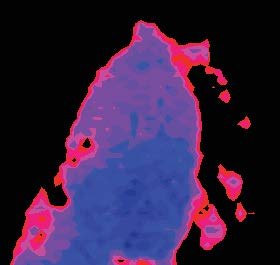28 June 2013
A reviewer for a top-ranked earth science journal says that a new research paper by Australian Synchrotron users could encourage many more geoscientists to use synchrotron techniques.
“Although synchrotron sources are rare and under-used by geoscientists in general, here is an application that may tempt many more to use it," the reviewer said. "It may be that in 20 years this will be viewed as a classic first paper describing a technique th at has become widely used by then ... my estimation is that acceptance and publication ... would be a major coup for the journal.”
at has become widely used by then ... my estimation is that acceptance and publication ... would be a major coup for the journal.”
These comments make it clear that the paper by associate professors Andrew Berry and Greg Yaxley and PhD candidate Brendan Hanger, recently published in the top-ranked earth science journal Geology, is a cut above the typical research paper.
The reviewer went on to say that: “An advance in analytical technique that allows mapping of oxidation state has been very desirable for a long time now, but no technique was developed that permitted it. The new technique uses a synchrotron source (XANES) to map Fe3+/total Fe and thus the oxidation state of mantle garnets. Furthermore, it maps the oxidation state on a small scale compared to any other mapping method for individual elements that do not lead to an image of the oxidation state”.
Andrew (Imperial College London and Australian National University), Greg and Brendan (Australian National University) and their collaborators from Universität Frankfurt, University of Tasmania and the Australian Synchrotron investigated the oxidation state of iron in garnets. Their garnet samples came from a garnet peridotite xenolith: a piece of the Earth’s upper mantle embedded in the Wesselton kimberlite in South Africa. The researchers used x-ray absorption near edge structure (XANES) spectroscopy at the x-ray fluorescence microscopy (XFM) beamline to produce quantitative maps of the ratio of ferric ions (Fe3+) to total iron present. The XANES map resolution was close to that obtained using an electron microprobe – but with the advantage of also providing information on oxidation state.
The synchrotron maps revealed different ratios of ferric to total iron between the garnet’s core (0.075) and the rim (0.125), in similar fashion to the zoning of other elements. The rim revealed evidence of an oxidising metasomatic event, i.e. an increase in oxidation state that occurred in the rock during interaction with a melt or fluid deep in the mantle. The researchers concluded from their synchrotron data that metasomatism of the Earth’s lithospheric mantle may have a greater impact on diamond stability than previously thought, with mantle metasomatism now appearing more likely to result in the breakdown of diamond.
Andrew J. Berry, Gregory M. Yaxley, Brendan J. Hanger, Alan B. Woodland, Martin D. de Jonge, Daryl L. Howard, David Paterson and Vadim S. Kamenetsky, Quantitative mapping of the oxidative effects of mantle metasomatism, Geology, June 2013, 41, 683-686, first published 16 April 2013.

Image right: backscattered electron image of zoned garnet in a matrix of kelyphite, olivine, and serpentine (Wesselton kimberlite, South Africa).
Image top right: Fe3+/ΣFe quantified for garnet by the colour scale (warm colours correspond to higher Fe3+/total Fe and cooler colours correspond to lower Fe3+/total Fe). Field of view is about 600 µm wide. (Modified from Fig.4, Geology, June 2013, 41, 683-686, reproduced by permission of the Geological Society of America.)
